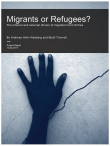Migranten of vluchtelingen? De interne en externe drivers van migratie uit Eritrea
Eritrea is de afgelopen tien jaar een van de grootste herkomstlanden van vluchtelingen en asielzoekers ter wereld. Het dominante verhaal dat deze trend verklaart, heeft betrekking op de combinatie van een zeer autoritaire en gemilitariseerde staatsstructuur, een oneindig en misbruikend nationaal dienstprogramma en brutale, wijdverspreide en systematische schendingen van de mensenrechten. Dit dominante verhaal is echter de afgelopen jaren steeds meer in vraag gesteld door degenen die beweren dat migratie uit Eritrea overwegend door economische aspiraties wordt gedreven en dat de Eritreërs eigenlijk een stagnerende economie ontvluchten die de burgers een levensvatbare toekomst ontneemt.
Dit rapport, door Andreas Holm Røsberg en Kjetil Tronvoll, wil de verschillende visies op migratie uit Eritrea verduidelijken.

Download publication
This report seeks to provide some clarity to the internal and external drivers of migration from Eritrea through: i) a thorough and critical assessment of research methodological challenges inherent in the Eritrean case; ii) a comprehensive and critical literature review of research and country of origin reports on Eritrea; and iii) compare and supplement the findings of the literature review with data obtained through interview survey conducted in four Eritrean refugee camps in Tigray, Ethiopia.
The report shows that flight from Eritrea is a function of a complex set of internal and external factors – a situation that is far too multifaceted to be adequately understood within the frames of two competing and simplified narratives.
There are enduring internal and external validity issues associated with much of the research on Eritrea, leaving much to be desired when it comes to the (certainty of) the accuracy of findings and our ability to generalize findings to the Eritrean population at large. The majority of the research on Eritrea, collaborated by this project survey, identifies the main internal drivers of migration as the national service programme, human rights abuse, expectations and aspirations of self-development, which accumulates into a sense of no hope for the future. These key internal drivers link up with the external pull factors of economic opportunities, fulfilment of citizenship rights and aspirations for modernity.
There is however uncertainty concerning how the identified drivers of migration, alone or through complex interaction, impact the individual’s choice to migrate, although it seems appropriate to assume that it varies considerably between individuals and most likely over time as well. There are also age and gender differences at play. It seems evident, however, that many Eritreans of all ages find the combined effects of some, or all, of these factors to outweigh the very real internal and external risks and uncertainties associated with fleeing their home country.